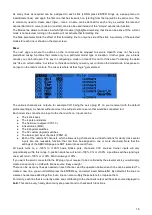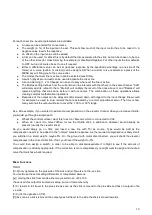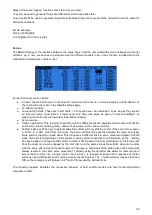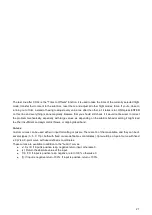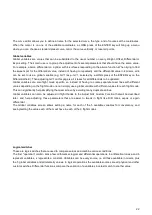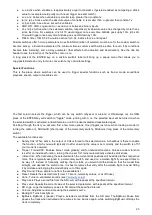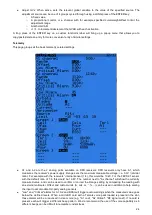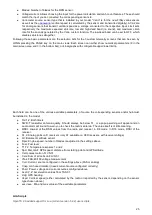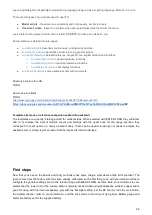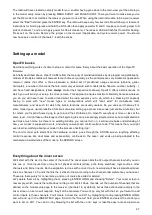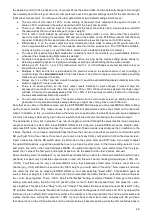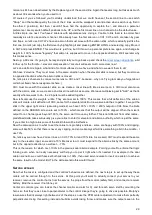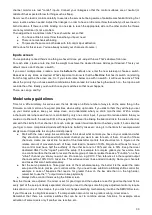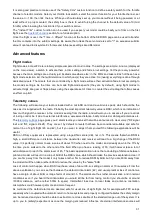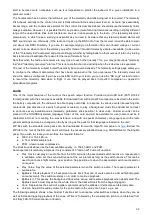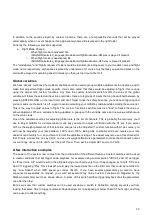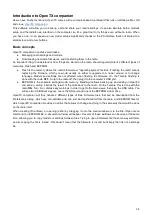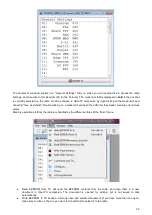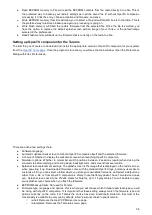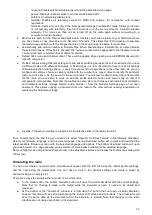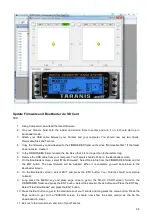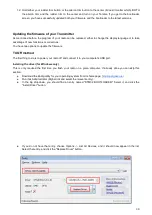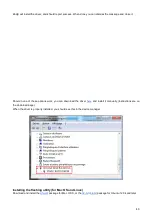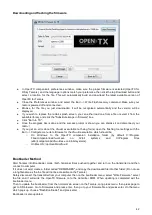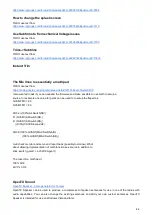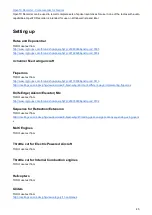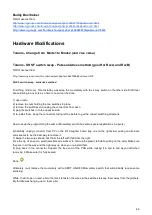
start to become more noticeable, such as it is impossible to predict the behavior of a given installation in a
particular model.
The Taranis also has an alarm that will warn you of the telemetry downlink being lost or recovered. The telemetry
link behaves similarly to the control link and is transmitted with the same power level, so it should have essentially
similar range, and the conservative alarms for the control link described above should ensure the telemetry link is
always available. However, it is possible that for any reason (manufacturing tolerances resulting in slightly different
range of the up and down links, local interference sources in close proximity to the radio,...) the telemetry link is lost
prematurely, in which case a warning is essential as you need to be aware that any telemetry-based alarms will
NOT sound anymore. Obviously, if the radio can't pick up the RSSI info from the receiver it won't be able to warn
you about low RSSI. Similarly, if you are for example relying on information from an onboard voltage or current
sensor to know when to land, the alarms you set for this won't sound if telemetry data is unavailable. So be aware
of the "Telemetry lost" audio alert and act accordingly, whether by falling back to other sources of info or by turning
back to land and investigate the reason for the loss of telemetry feed.
Note that when the radio and receiver are very close to each other (usually <1m) you may get spurious "telemetry
lost" and "telemetry recovered" alarms. This is not a malfunction and will stop when the 2 devices are separated.
The rest of the telemetry subject in itself has mostly been covered already. The telemetry settings page allows you
to configure the different parameters that have been explained in the menu overviews. The telemetry views will
show the data as configured. If you have a microSD card in your radio, you can use the "SD Logs" custom function
to record the telemetry data while in flight. It can then be played back in OpenTX companion or opened in
spreadsheet programs.
Audio
One of the major features of the radio is the speech output function. Provided a microSD card (FAT12/16/32
format) loaded with the sound pack available for download from within OpenTX companion is inserted in the slot in
the battery compartment, the radio will be able to play audio files in response to various events like reaching trim
center/ends and activation of a switch (physical or custom), to play a background music file, and last but not least
to announce every available value (telemetry, parameter, stick position) in clear voice. Custom sounds can be
placed in the SOUNDS/(selected_language) folder of the card and will be available for use (name must be 8
characters at most, not counting the .wav extension, and with no special characters). Language is set in the radio
general settings and can be changed on the fly as long as the pack for that language is loaded on the card.
ZIP files with the standard voice packs can be downloaded from within OpenTX companion, or
. Extract the
ZIP file to the root of the SD card, and it will create the necessary subdirectories (e.g. SOUNDS/en for the English
pack). If you wish to create your own files, the required format is:
●
WAV, 8 or 16 bit, Mono
●
8, 16 or 32kHz sample rate
●
PCM, u-law or a-law compression
The stock sounds above use the best available quality, i.e. 16bit, 32kHz and PCM.
Audio operation is relatively simple as it only consists of 5 "and a half" Custom Functions:
●
Play Track: Just play an audio file from the SD card when the associated switch is active. A repeat option
is available, when set the sound will repeat at the set interval as long as the switch is active. This can be
used to announce flight modes, gear position, flap position etc when the associated switch is activated or
on request.
●
Play Value: Say the value of the selected parameter when the switch is active. The repeat parameter is
available too.
●
BgMusic: Starts playback of a background music track (that can of course also be a timed flight program
announcement). The switch must stay on in order to continue playback.
●
BgMusic ||: This pauses the background track while active, and resumes playback when deactivated. The
BgMusic switch must stay active the whole time or the track will start from the beginning again.
●
Vario: Reproduces the sound of a glider variometer using the altitude or Vertical speed telemetry data.
●
Volume: Adjusts the audio volume for the entire radio to the value of an input, e.g. a pot.
The following example shows a few Custom Functions set to announce what switches activate when they are, as
well as SHdown triggering playback of the value of Timer 2 followed by the consumption (mAh count obtained from
an FrSky FAS-100 current sensor onboard).
32
Summary of Contents for OpenTX 2.0+
Page 41: ...41...
Page 47: ...Taranis Updating internal XJT module firmware 47...

